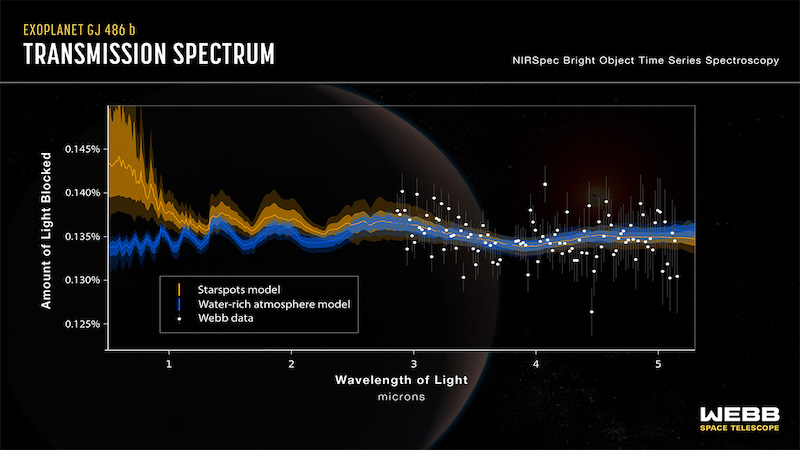
Astronomers have found evidence for water vapor in the atmospheres of a growing number of exoplanets. So far, these have been planets much larger than Earth, like mini-Neptunes or super-Jupiters. But what about smaller, rocky planets closer in size to Earth? It’s not as easy to detect water vapor on small worlds that are so far away from us. But on May 1, 2023, researchers in the U.S. and U.K. reported that they identified water vapor in either the atmosphere of a rocky planet or the red dwarf star it orbits. They used the Webb Space Telescope to make the observations from 26 light-years away.
A draft version of the researchers’ new paper, published on April 10, 2023, has been accepted for publication in The Astrophysical Journal Letters.
Webb detects water vapor
The planet, GJ 486 b, is rocky, about 30% larger than Earth and three times as massive. That makes it what astronomers call a super-Earth. It orbits very close to its star, completing an orbit in only 1.5 days. So, unfortunately, with an estimated temperature of 800 degrees Fahrenheit (430 C), it likely isn’t a good place to look for life. Scientists say it is also likely tidally locked, therefore it always keeps the same side facing its star.
Despite the high temperatures, it is still possible that GJ 486 b could have water vapor in its atmosphere. That is, of course, if there is an atmosphere, which isn’t known yet.
And indeed, Webb’s observations did show hints of water vapor. Exciting, right?
On the planet … or its star?
The big question is: Is the water vapor on the planet, or could it actually be on the star?
Lead author Sarah Moran of the University of Arizona stated:
We see a signal and it’s almost certainly due to water. But we can’t tell yet if that water is part of the planet’s atmosphere, meaning the planet has an atmosphere, or if we’re just seeing a water signature coming from the star.
Kevin Stevenson of the Johns Hopkins University Applied Physics Laboratory added:
Water vapor in an atmosphere on a hot rocky planet would represent a major breakthrough for exoplanet science. But we must be careful and make sure that the star is not the culprit.
Planetary transits provide clues
So, how did the researchers detect the water vapor? Webb observed GJ 486 b while it transited in front of its star, as seen from Earth. It did so not once, but twice. Each transit lasted about one hour. The researchers used three techniques to analyze the data from Webb.
Intriguingly, all three methods showed similar results. The transmission spectrum from the planet and star was mostly flat. There was, however, an interesting spike at the shortest infrared wavelengths. What was causing the spike? Which molecules did the astronomers detect? To find out, the researchers ran computer models using different kinds of molecules. It turned out that the most likely explanation was water vapor.

Water vapor in starspots?
If the water vapor is not in the planet’s atmosphere, then it would be in the red dwarf’s starspots, dark spots on the star like sunspots on our own sun. How is that possible? Surprisingly, water vapor can exist in sunspots because they are much cooler in comparison to the surrounding surface of the sun.
The researchers say that because GJ 486 b’s star is already a lot cooler than our sun, its starpots would be even cooler than the sun’s sunspots. Therefore, the spots could contain even more water vapor. If the planet crossed a starspot during its transit, it might look like the water vapor is on the planet when really it is in the starspot. It’s a plausible theory, although there’s one problem. The researchers never saw the planet transit in front of any starspots. But it’s still possible that there could be starspots that the astronomers didn’t see. Co-author Ryan MacDonald of the University of Michigan said:
We didn’t observe evidence of the planet crossing any starspots during the transits. But that doesn’t mean that there aren’t spots elsewhere on the star. And that’s exactly the physical scenario that would imprint this water signal into the data and could wind up looking like a planetary atmosphere.
Additional observations needed
So, for the moment, it’s still unclear whether the source of the water vapor is the planet or its star. The researchers say they need additional observations with two instruments on Webb to figure out the real source of the water vapor.
The Mid-Infrared Instrument (MIRI) will observe the planet’s day side. If the planet has no atmosphere, or just a thin atmosphere, then the hottest part of the day side of the planet would be at the point directly facing the star. However, if the hottest point is shifted, that would indicate an atmosphere where heat can circulate.
In addition, the Near-Infrared Imager and Slitless Spectrograph (NIRISS) will be able to differentiate between the planetary atmosphere and starspot scenarios. But it’s the combination of instruments that should finally determine conclusively whether there really is water vapor on GJ 486 b. As Stevenson noted:
It’s joining multiple instruments together that will really pin down whether or not this planet has an atmosphere.
In 2019, astronomers reported finding water vapor in the atmosphere of another super-Earth, K2-18b. This planet was considered to be potentially habitable. Later, however, researchers said that the planet is more of a mini-Neptune, with a deep hydrogen atmosphere and likely no solid surface.
Bottom line: Astronomers using NASA’s Webb Space Telescope have found signs of water vapor. But is it on a rocky exoplanet or the planet’s star?











